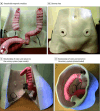Three-Dimensional-Printed Models and Shared Decision-Making: A Cluster Randomized Clinical Trial
- PMID: 40459895
- PMCID: PMC12134953
- DOI: 10.1001/jamanetworkopen.2025.13187
Three-Dimensional-Printed Models and Shared Decision-Making: A Cluster Randomized Clinical Trial
Abstract
Importance: Patients undergoing surgery report a lack of involvement in health care decisions and increased anxiety. Three-dimensional (3D)-printed models serve as educational tools to encourage patient engagement, reduce anxiety levels, and aid understanding.
Objective: To determine the impact of 3D-printed anatomic models on shared decision-making (SDM) and patient anxiety during the preoperative surgical consultation for colon or rectal resection.
Design, setting, and participants: This single-center cluster randomized clinical trial was conducted from March 2022 to June 2023 at a colorectal surgery clinic at an academic medical institution and included adult patients scheduled for partial or complete colon and/or rectal resection for colorectal cancer, diverticular disease, or inflammatory bowel disease.
Intervention: Six surgeons (clusters) were randomized to counsel patients using a modular 3D-printed model or providing usual care during preoperative clinic visits.
Main outcomes and measures: The primary outcome was the patient's perception of involvement in decision-making using the 9-item Shared Decision Making Questionnaire. The secondary outcome was the change in anxiety level measured using the State-Trait Anxiety Inventory. Patient characteristics were compared between the 3D-printed model and usual care arms using a χ2 test for categorical variables and a t test for comparisons between continuous variables.
Results: Among the 51 patients enrolled (mean [SD] age, 50.7 [14.5] years; 28 female [54.9%]), 28 (54.9%) were in the 3D-printed model arm and 23 (45.1%) were in the usual care arm. Patients counseled with the 3D-printed model reported a significantly higher involvement in SDM compared with those in the usual care group (mean [SD] score, 89.5 [17.6] vs 80.5 [14.4]; P = .01). Additionally, using a 3D-printed model significantly reduced mean anxiety scores (from 53.5 [SD, 21.2] to 44.1 [SD, 15.8]) compared with conventional methods (from 50.4 [SD, 18.3] to 48.0 [SD, 15.3]) (P = .04).
Conclusions and relevance: This cluster randomized clinical trial found that counseling aided with 3D models during preoperative clinic visits improved SDM among patients undergoing colorectal surgery. This study highlights the potential of 3D-printed models as a tool to enhance patient-clinician collaborations. Given the findings, further research into the effectiveness and implementation of these tools is recommended in more diverse clinical settings.
Trial registration: ClinicalTrials.gov Identifier: NCT06625008.
Conflict of interest statement
Figures



Comment in
- doi: 10.1001/jamanetworkopen.2025.13204
References
-
- Willemin D, del Mar Rodriguez M, Cadelina W. Improving the patient experience through a preoperative educational initiative. J Perianesth Nurs. 2022;37(4):e20. doi: 10.1016/j.jopan.2022.05.053 - DOI
Publication types
MeSH terms
Associated data
LinkOut - more resources
Full Text Sources
Medical

